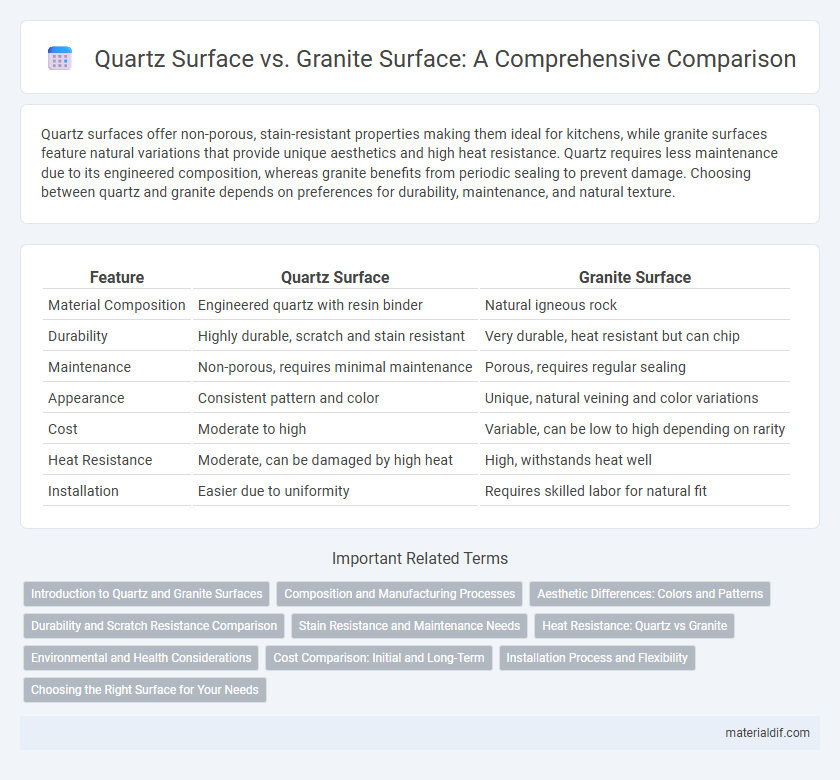Quartz surfaces offer non-porous, stain-resistant properties making them ideal for kitchens, while granite surfaces feature natural variations that provide unique aesthetics and high heat resistance. Quartz requires less maintenance due to its engineered composition, whereas granite benefits from periodic sealing to prevent damage. Choosing between quartz and granite depends on preferences for durability, maintenance, and natural texture.
Table of Comparison
| Feature | Quartz Surface | Granite Surface |
|---|---|---|
| Material Composition | Engineered quartz with resin binder | Natural igneous rock |
| Durability | Highly durable, scratch and stain resistant | Very durable, heat resistant but can chip |
| Maintenance | Non-porous, requires minimal maintenance | Porous, requires regular sealing |
| Appearance | Consistent pattern and color | Unique, natural veining and color variations |
| Cost | Moderate to high | Variable, can be low to high depending on rarity |
| Heat Resistance | Moderate, can be damaged by high heat | High, withstands heat well |
| Installation | Easier due to uniformity | Requires skilled labor for natural fit |
Introduction to Quartz and Granite Surfaces
Quartz surfaces are engineered stone products composed primarily of natural quartz crystals combined with resins and pigments, providing durable, non-porous countertops that resist stains and scratches. Granite surfaces are natural stone slabs formed from cooled magma, featuring unique mineral patterns and requiring periodic sealing to maintain their resistance to moisture and bacteria. Both materials offer aesthetic appeal and strength, but quartz provides uniformity and low maintenance, while granite showcases natural variations and a classic, earthy look.
Composition and Manufacturing Processes
Quartz surfaces consist primarily of about 90-95% engineered quartz crystals combined with resin binders and pigments, creating a non-porous, durable material. In contrast, granite surfaces are natural stone, formed through the slow crystallization of magma beneath the Earth's surface, resulting in unique mineral patterns and inherent variability. The manufacturing process for quartz involves crushing natural quartz and mixing it with resins before curing under heat and pressure, whereas granite slabs are quarried, cut, and polished without added synthetic components.
Aesthetic Differences: Colors and Patterns
Quartz surfaces offer a broader and more consistent range of colors and patterns due to their engineered composition, enabling precise control over appearance. Granite surfaces exhibit natural variations with unique veining and speckles, creating each slab's distinctive, organic look. Homeowners seeking uniformity may prefer quartz, while those valuing natural stone's unpredictability often choose granite.
Durability and Scratch Resistance Comparison
Quartz surfaces offer superior durability compared to granite due to their engineered composition of natural quartz crystals blended with resins, providing enhanced resistance to chipping and cracking. Scratch resistance in quartz is significantly higher as its non-porous surface resists abrasion better than granite, which can develop surface scratches over time despite its hardness. While granite remains a strong natural stone option, quartz's consistent hardness rating around 7 on the Mohs scale ensures longer-lasting surface integrity in high-traffic kitchen environments.
Stain Resistance and Maintenance Needs
Quartz surfaces offer superior stain resistance compared to granite due to their non-porous composition, which prevents liquid absorption and reduces the risk of discoloration. Maintenance for quartz is minimal, requiring only regular wiping with mild soap and water, whereas granite needs periodic sealing to maintain its stain resistance. Granite's porous nature makes it more vulnerable to stains from oils, wine, and acidic substances, increasing its overall maintenance demands.
Heat Resistance: Quartz vs Granite
Quartz surfaces exhibit moderate heat resistance withstanding temperatures up to 150degF (65degC) before potential damage occurs, making them vulnerable to heat from hot pots or pans. Granite surfaces offer superior heat resistance, enduring temperatures well over 480degF (250degC) without discoloration or structural impact, making granite ideal for kitchen environments involving direct heat exposure. Choosing granite over quartz ensures enhanced durability against thermal stress in high-heat cooking scenarios.
Environmental and Health Considerations
Quartz surfaces are engineered using natural quartz combined with resins and pigments, which may emit volatile organic compounds (VOCs) affecting indoor air quality during installation. Granite is a natural stone with minimal processing and does not release VOCs, but quarrying granite involves significant environmental disruption and high energy use. Both materials are durable and safe for regular use, yet quartz's resin content raises concerns about long-term chemical exposure, while granite mining poses greater ecological impact.
Cost Comparison: Initial and Long-Term
Quartz surfaces typically have a higher initial cost, ranging from $50 to $150 per square foot, compared to granite surfaces, which generally cost between $40 and $100 per square foot. Long-term costs favor quartz due to its lower maintenance requirements, resistance to staining, and no need for periodic sealing, unlike granite that requires regular sealing and potential repairs. Investing in quartz can reduce overall expenses over time despite the higher upfront price.
Installation Process and Flexibility
Quartz surfaces offer a more streamlined installation process compared to granite, as they are engineered materials that come in uniform slab sizes, reducing on-site customization and fitting time. Granite requires more precise cutting and may need additional reinforcement due to its natural variances and increased weight, making installation more labor-intensive. Quartz's consistency allows for easier handling and flexibility in design, enabling installers to adapt quickly to various layout requirements with minimal adjustments.
Choosing the Right Surface for Your Needs
Quartz surfaces offer non-porous, low-maintenance properties ideal for kitchens requiring hygiene and stain resistance, while granite surfaces provide natural stone durability with unique patterns suitable for heat resistance and outdoor use. Quartz typically requires less sealing and is more consistent in appearance, making it a preferred choice for modern, uniform designs. Granite's natural variance and ability to withstand high temperatures make it a better option for heavy-use or rustic aesthetics.
Quartz Surface vs Granite Surface Infographic

 materialdif.com
materialdif.com